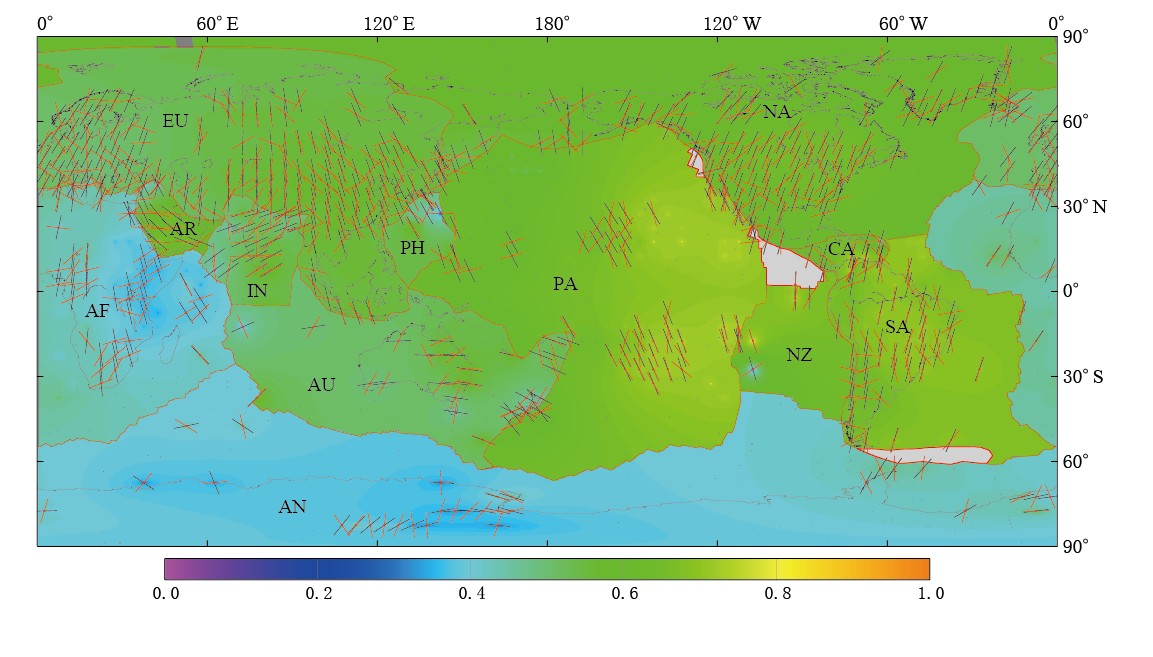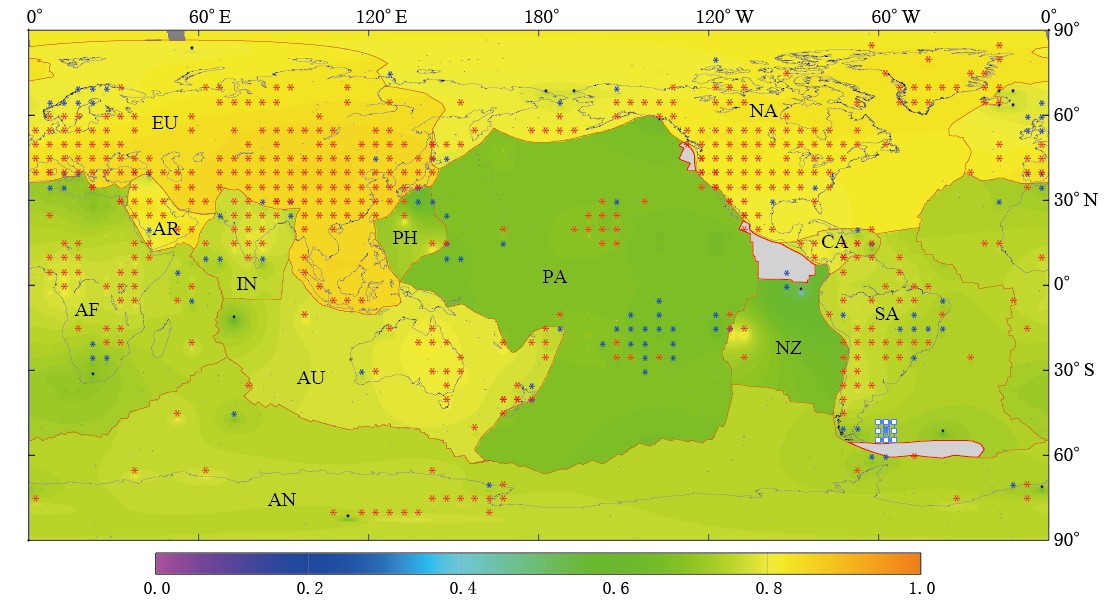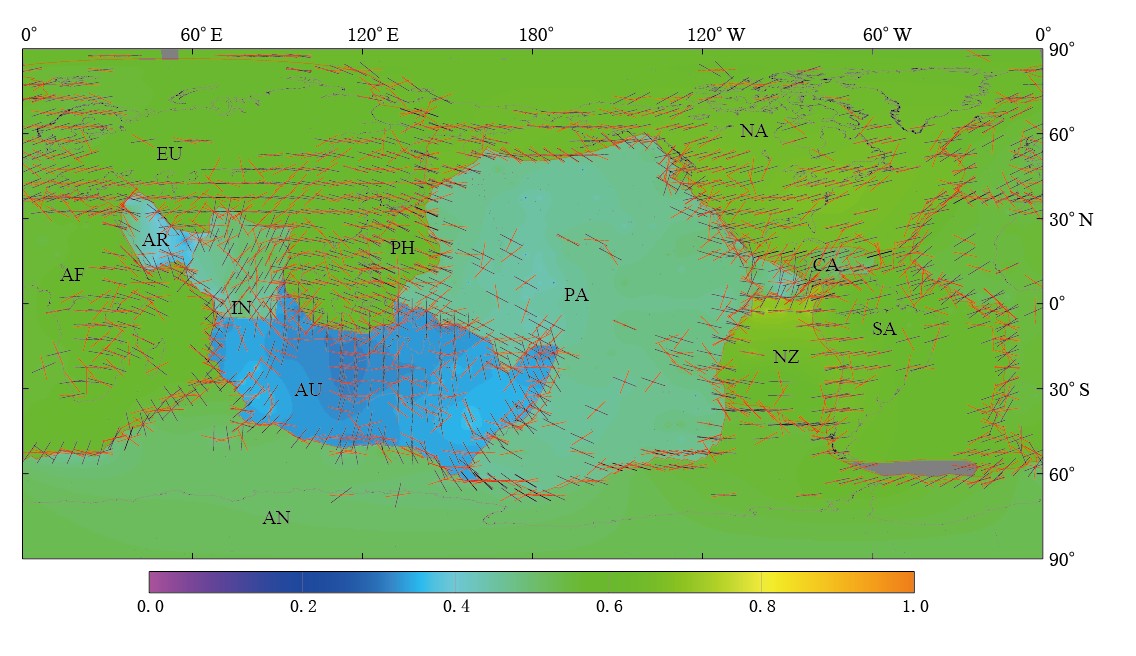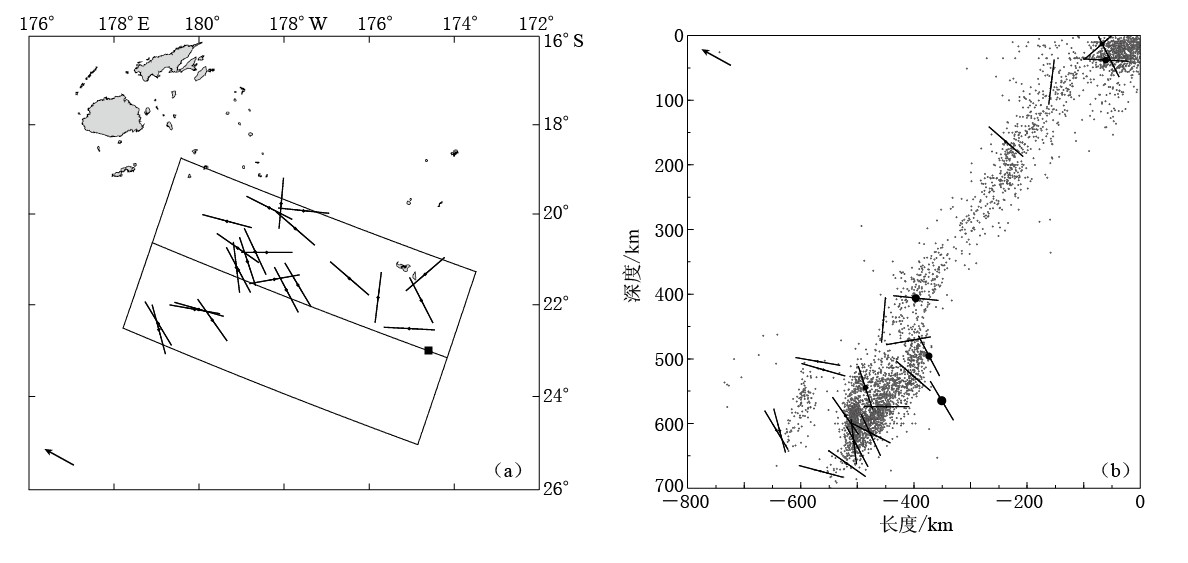Statistical analysis on the correlation between plate motion and seismic anisotropy as well as stress field
-
摘要: 利用收集到的各种来源共计7 959组的地震各向异性观测数据和21 750组应力场数据,结合板块绝对运动模型计算给出的各板块的运动规律,分别统计分析了板块运动与地震各向异性及应力场的相关性,并对板块运动对地震各向异性及应力场特征产生的影响进行了分析. 统计结果表明,阿拉伯、 加勒比、 胡安德富卡、 北美、 纳兹卡、 太平洋和南美板块上地震各向异性与板块运动均具有较好的相关性,而非洲、 南极洲、 澳大利亚、 欧亚、 印度和菲律宾板块上二者的相关性则相对较差. 讨论分析发现,板块运动拖动软流圈流动、 橄榄岩晶格优选方位、 化石各向异性和地幔流动或岩石圈流动等因素均在一定程度上控制并影响着地震各向异性与板块运动的一致性. 而板块基底拖曳力、 洋脊推力、 浮力作用和碰撞及俯冲作用等多种因素共同制约了板块运动与应力场的相关性,使得非洲、 可可斯、 欧亚、 胡安德富卡、 北美、 纳兹卡、 菲律宾和南美板块上二者的相关性较好,其它板块上其相关性则较差. 对于俯冲带地区,由于俯冲机制的复杂性和软流圈、 岩石圈地幔流动方向的不确定性,其板块运动与地震各向异性及应力场的相关性图像表现复杂,需要结合具体的俯冲带构造进行近一步研究.Abstract: With the 7 959 observation seismic data and 21 750 stress data which have been collected from various sources, and combined the characteristics of each plate ’ s absolute motion, this paper statistically analyzed the correlation between plate motion and seismic anisotropy as well as stress field, and studied how the plate motion affects characteristic of seismic anisotropy and stress field. The statistical results indicate that a quite positive correlation between plate motion and seismic anisotropy exists in the Arabian, Caribbean, Juan de Fuca, North American, Nazca, Pacific and South American plates, whereas the correlation in plates of African, Antarctic, Australian, Eurasian, Indian and Philippine is relatively poor. Discussion and analysis shows that, whole the block motion dragging asthenospheric flow, lattice preferred orientation of olivinite, fossil anisotropy and mantle flow or lithosphere flow control or affect the consistency between seismic anisotropy and the plate motion to a certain extent. Various factors such as plate basal drag force, ridges thrust, buoyancy, collision and subduction constrain the relation between plate motion and stress field in a combined action, resulting in a good correlation in African, Cocos, Eurasian, Juan de Fuca, North American, Nazca, Philippine and South American plates, and a poor correlation in other plates. For the subduction zone areas, the image of correlativity between plate motion and seismic anisotropy as well as stress field is intricate due to the complexity of the subduction mechanism and the non-directional flow of asthenosphere, lithospheric mantle, and it needs further research in combination with the specific subduction zone structure.
-
Keywords:
- seismic anisotropy /
- stress field /
- plate motion /
- correlation /
- statistical analysis
-
-
图 1 HS3-NUVEL-1A模型板块绝对运动方位角与地震各向异性快波偏振方向的相关性黑色条棒表示板块绝对运动方位角, 红色条棒表示各向异性偏振方向. 色标表示二者相关性的大小,值越大表示相关性越好, 反之亦然. AF: 非洲板块; AN: 南极洲板块; AR: 阿拉伯板块; AU: 澳大利亚板块; CA:加勒比板块; EU:欧亚板块; IN:印度板块; NA: 北美板块; NZ: 纳兹卡板块; PA: 太平洋板块; PH: 菲律宾板块; SA: 南美板块
Figure 1. Correlativity between the fast splitting direction of seismic anisotropy and the azimuth of absolute plate motion in HS3-NUVEL-1A modelThe black bars indicate the azimuth of plate absolute motion; red bars indicate the direction of fast splitting; color scale indicates that the correlation between these two parameters; the big value shows a good correlation, and vice versa. AF: African plate; AN: Antarctic plate; AR: Arabian plate; AU: Australian plate; CA: Caribbean plate; EU: Eurasian plate; IN: Indian plate; NA: North American plate; NZ: Nazca plate; PA: Pacific plate; PH: Philippine plate; SA: South American plate
图 2 HS3-NUVEL-1A模型地震各向异性时间延迟与板块绝对运动的慢度的相关性 红色星号表示相关性在0.67—1.0之间的数据点, 蓝色星号表示相关性在0.33—0.67 之间的数据点, 黑色星号表示相关性在0—0.33之间的数据点. 色标表示二者相关性的大小, 值越大表示相关性越好, 反之亦然. 图中板块名称同
Figure 2. Correlativity between the delay time of seismic anisotropy and the slowness of plate absolute motion in HS3-NUVEL-1A model The red, blue, and black stars indicate the point with correlativity coefficient of 0.67—1.0, 0.33—0.67, and 0—0.33, respectively. Color scale indicates that the correlation between these two parameters; the big value shows a good correlation, and vice versa
图 3 HS3-NUVEL-1A模型板块绝对运动方位角与最大水平主应力方向的相关性黑色条棒表示板块绝对运动方位角, 红色条棒表示最大水平主应力方向. 色标表示二者相关性大小, 值越大表示相关性越好, 反之亦然. 图中板块名称同
Figure 3. Correlativity between the direction of maximum horizontal principal stress and the azimuth of plate absolute motion in HS3-NUVEL-1A model The black bars indicate the azimuth of plate absolute motion, and the red bars indicate the direction of maximum principal stress. Color scale indicates that the correlation between these two parameters; the big value shows a good correlation, and vice versa
图 4 地震各向异性数据在汤加俯冲带内(a)及其在深度上(b)的分布黑色箭头表示该处板块绝对运动的方向, 黑色条棒表示地震各向异性快波偏振方向. 图(b)横坐标表示俯冲带的延伸长度
Figure 4. Distribution of seismic anisotropy data in Tonga subduction zone (a) and their distribution in depth (b) The black arrow shows the plate absolute motion direction and the bar shows the direction of fast wave polarization of seismic anisotropy. Horizontal ordinate in Fig.4b indicates the extension length of subduction zones
表 1 板块运动与地震各向异性及应力场的相关性统计结果
Table 1 Statistical result of the correlativities between plate motion and seismic anisotropy as well as stress field
板块 1-Δø 1-Δδ t 1-Δφ 0—0.33 0.33—0.67 0.67—1.0 0—0.33 0.33—0.67 0.67—1.0 0—0.33 0.33—0.67 0.67—1.0 AF 37% 45% 18% 2% 29% 69% 25% 33% 42% AN 48% 35% 16% 6% 19% 74% 26% 41% 33% AR 31% 23% 46% 0% 15% 85% 50% 19% 31% AU 29% 39% 32% 4% 14% 82% 51% 40% 9% CA 11% 44% 45% 0% 22% 78% 24% 52% 24% CO 40% 13% 47% EU 24% 44% 32% 3% 8% 89% 20% 38% 42% IN 27% 45% 27% 0% 32% 68% 36% 44% 21% JF 0% 0% 100% 0% 0% 100% 33% 0% 67% NA 18% 32% 50% 2% 7% 91% 14% 33% 53% NZ 17% 33% 50% 17% 33% 50% 16% 32% 52% PA 17% 25% 58% 2% 47% 51% 34% 40% 26% PH 29% 43% 28% 0% 43% 57% 14% 43% 43% SA 12% 33% 55% 2% 22% 76% 22% 31% 47% SC 注: 百分比是指在各个范围内的数据占整个板块上总数据的百分比, 可以看作是地震各向异性与板块运动的相关系数. 板块简称所对应的名称: AF: 非洲板块; AN: 南极洲板块; AR: 阿拉伯板块; AU: 澳大利亚板块; CA: 加勒比板块; CO: 可可斯板块; EU: 欧亚板块; IN: 印度板块; JF: 胡安德富卡板块; NA: 北美板块; NZ: 纳兹卡板块; PA: 太平洋板块; PH: 菲律宾板块; SA: 南美板块; SC: 斯科舍板块. -
常利军, 王椿镛, 丁志峰. 2006. 云南地区SKS波分裂研究[J]. 地球物理学报,49 (1): 197-204. 常利军, 王椿镛, 丁志峰. 2008. 四川及邻区上地幔各向异性研究[J]. 中国科学: D辑, 38 (12): 1589-1599. 常利军, 王椿镛, 丁志峰. 2009. 中国东部上地幔各向异性研究[J]. 中国科学: D辑, 39 (9): 1169-1178. 丁志峰, 曾融生. 1996. 青藏高原横波分裂的观测研究[J]. 地球物理学报,39 (2): 211-219. 董英君, 薛光琦, 马开义, 姜枚. 1999. 阿尔金断裂系及邻区剪切波各向异性研究[J]. 地球物理学进展,14 (4): 58-65. 高祥林, 罗焕炎, 平原和朗. 1994. 日本俯冲带应力产生与传播的数值模拟[J]. 地震地质,16 (2): 97-108. 高原, 滕吉文. 2005. 中国大陆地壳与上地幔地震各向异性研究[J]. 地球物理学进展,20 (1): 180-185. 黄玺瑛, 魏东平, 陈棋福, 陈虹. 2003. 全球观测应力场的短波分量分析[J]. 地震学报,25 (1): 40-46. 姜枚, 许志琴, Hirn A, 刘妍, 董英君. 2001. 青藏高原及其部分邻区地震各向异性和上地幔特征[J]. 地球学报,22 (2): 111-116. 刘希强, 郑冶真, 周蕙兰. 1998. 剪切波在双层方位各向异性介质传播中分裂参数的变化特性[J]. 地球物理学报,41 (5): 680-690. 吕庆田, 马开义, 姜枚, Hirn A, Nercessian A. 1996. 青藏高原南部下的横波各向异性[J]. 地震学报,18 (2): 215-223. 史大年, 董英君, 姜枚, 赵红, Poupinet G, Hirn A, Nercessian A. 1996. 西藏定日-青海格尔木上地幔各向异性研究[J]. 地质学报,70 (4): 291-297. 孙圣思, 嵇少丞. 2011. 大洋板块俯冲带地震波各向异性及剪切波分裂的成因机制[J]. 大地构造与成矿学,35 (4): 628-647. 孙振添, 魏东平. 2013. 全球地震各向异性数据汇编及相关研究综述[J]. 地球物理学进展,28 (3): 1280-1288. 滕吉文. 2002. 中国地球深部结构和深层动力过程与主体发展方向[J]. 地质论评,48 (2): 125-139. 王椿镛, 常利军, 吕智勇, 秦嘉政, 苏伟. 2007. 青藏高原东部上地幔各向异性及相关的壳幔耦合型式[J]. 中国科学: D辑, 37 (4): 495-503. 魏东平, 濑野徹三. 2000. 东亚北部地区现代板块构造的运动学分析[J]. 地球物理学报,43 (1): 53-63. 徐纪人, 赵志新. 2006. 青藏高原及其周围地区区域应力场与构造运动特征[J]. 中国地质,33 (2): 275-285. 徐纪人, 赵志新. 2008. 中国大陆地壳应力场与构造运动区域特征研究[J]. 地球物理学报,51 (3): 770-781. 许忠淮. 2001. 东亚地区现今构造应力图的编制[J]. 地震学报,23 (5): 492-501. 杨晓松, 金振民, 马瑾, Huenges E, Schilling F. 2002. 青藏高原北部异常SKS分裂成因的初步探讨: 被熔体强化的岩石圈各向异性[J]. 地球物理学报,45 (6): 821-831. 张东宁, 袁松涌, 沈正康. 2007. 青藏高原现代地壳运动与活动断裂带关系的模拟实验[J]. 地球物理学报,50 (1): 153-162. 张克亮, 魏东平. 2011. 双地震带的影响因素探讨[J]. 地球物理学报,54 (11): 2838-2850. 郑斯华, 高原. 1994. 中国大陆岩石层的方位各向异性[J]. 地震学报,16 (2): 131-140. Cloetingh S, Wortel R. 1986. Stress in the Indo-Australian plate[J]. Tectonophysics,132 (1): 49-67.
Coblentz D D, Sandiford M. 1994. Tectonic stresses in the African plate: Constraints on the ambient lithospheric stress state[J]. Geology,22 (9): 831-834.
Coblentz D D, Richardson R M. 1996. Analysis of the South American intraplate stress field[J]. J Geophys Res,101 (B4): 8643-8657.
Crampin S, Booth D C. 1985. Shear wave polarization near the North Anatolian fault: Ⅱ. Interpretation in terms of crack-induced anisotropy[J]. Geophys J R astr Soc,83 (1): 75- 92.
Davis J C. 2002. Statistics and Data Analysis in Geology[M].3rd. America: Kansas Geological Survey The University of Kansas: 316-342.
Debayle E, Kennett B, Priestley K. 2005. Global azimuthal seismic anisotropy and the unique platemotion deformation of Australia[J]. Nature,433 (3):509-512.
Debayle E, Kennett B. 2000. Anisotropy in the Australian upper mantle from waveform inversion[J].Earth Planet Sci Lett,184 (1): 339-351.
DeMets C, Gordon R G, Argus D F, Stein S. 1990. Current plate motions[J]. Geophys J Int,101 (2): 425-478.
DeMets C, Gordon R G, Argus D F, Stein S. 1994. Effect of recent revisions to the geomagnetic reversal time scale on estimates of current plate motions[J]. Geophys Res Lett,21 (20): 2191-2194.
DeMets C, Gordon R G, Argus D F. 2010. Geologically current plate motions[J]. Geophys JInt,181 (1): 1-80.
Flesch L, Holt W, Silver P, Stephenson M, Wang C, Chan W. 2005. Constraining the extent of crust mantle coupling in central Asia using GPS, geologic, and shear wave splitting data[J]. Earth Planet Sci Lett,238 (1): 248-268.
Fouch M J, Stephane R. 2006. Seismic anisotropy beneath stable continental interiors[J]. Phys Earth Planet Inter,158 (2/4): 292-320.
Gripp A E, Gordon R G. 1990. Current plate velocities relative to the hotspots incorporating the NUVEL-1 global plate motion model[J]. Geophys Res Lett,17 (8): 1109-1112.
Gripp A E, Gordon R G. 2002. Young tracks of hotspots and current plate velocities[J]. Geophys J Inte,150 (2): 321 -361.
Heidbach O, Tingay M, Barth A, Reinecker J, Kurfer D, Muller B. 2008. The World Stress Map Database Release2008[R]. Commission for the Geological Map of the World, Paris, 1:46 M,2008, doi:10.1594/GFZ.WSMRel,2008.
Heintz M, Kennett B. 2005. Continental scale shear wave splitting analysis: Investigation of seismic anisotropy underneath the Australian continent[J]. Earth Planet Sci Lett,236 (1/2): 106-119.
Hess H. 1964. Seismic anisotropy of the uppermost mantle underoceans[J]. Nature,203 (8): 629-631.
Hillis R R, Reynolds S D. 2000. The Australian stress map[J]. J Geol Soc,157 (1): 915-921.
Hillis R R, Reynolds S D. 2003. In situ stress field of Australia[J]. Geological Society of America Special Paper,372 : 49-58.
Holtzman B K, Kendall J M. 2010. Organized melt, seismic anisotropy, and plate boundary lubrication[J]. Geochem Geophys Geosyst,11 (12): Q0AB06, doi:10.1029/2010GC003296.
Huang Z, Zhao D, Wang L. 2011. Shear wave anisotropy in the crust, mantle wedge, and subducting Pacific slab under northeast Japan[J]. Geochem Geophys Geosyst,12 (1): Q01002, doi:10.1029/2010GC003343.
Karato S. 1986. Does partial melting reduce the creep strength of the upper mantle?[J]. Nature,319 : 309-310.
Kosarian M, Davis P M. 2011. The relationship between upper mantle anisotropic Structures beneath California, transpression, and absolute plate motions[J]. J Geophys Res,116 (B8):B08307, doi:10.1029/2010JB007742.
Kreemer C. 2009. Absolute plate motions constrained by shear wave splitting orientations with implications for hot spot motions and mantle flow[J]. J Geophys Res,114 (B10): B10405, doi:10.1029/2009JB006416.
Minster J B, Jordan T H. 1978. Present-day plate motions[J]. J Geophys Res,83 (B11): 5331- 5354.
Müller B, Zoback M L, Fuchs K, Mastin L, Gregersen S, Pavoni N, Stephansson O, Ljunggren C. 1992. Regional patterns of tectonic stress in Europe[J]. J Geophys Res,97 (B8): 11783-11803.
Müller C. 2001. Upper mantle seismic anisotropy beneath Antarctica and the Scotia Sea region[J].Geophys J Int,147 (1): 105-122.
Poirier J P, Price G D. 1996. Primary slip system of the Lithosphere-Asthenosphere System[J].Phys Earth Planet Inter,110 (1): 147-156.
Rabbel W, Mooney W D. 1996. Seismic anisotropy of the crystalline crust, what does it tell us? [J]. Terra Nova,8 (1): 16-21.
Richardson R M, Reding L M. 1991. North American plate dynamics[J]. J Geophys Res,96 (B7): 12201-12212, 12223.
Richardson R M. 1992. Ridge forces, absolute plate motions, and the intraplate stress field[J]. J Geophys Res,97 (B8): 11739-11748.
Russo R, Gallego A, Comte D, Mocanu V I, Murdie R E, Vandeca J C. 2010. Source-side shear wave splitting and upper mantle flow in the Chile Ridge subduction region[J]. Geology,38 (8): 707-710.
Shutt D, Fouch M. 2001. Upper mantle seismic anisotropy database[EB/OL]. [2011-01-14]. http://geophysics.asu.edu/anisotropy/upper/index.html.
Silver P G, Russo R, Bertelloni C L.1998. Coupling of South American and African plate motionand deformation[J]. Science,279 (5347): 60-63.
Vinnik L P, Makeyeva L, Milev A. 1992. Global patterns of azimuthal anisotropy and deformationsin the continental mantle[J]. Geophys J Int,111 (3): 433-447.
Walker K T, Nyblade A, Simon L, Bokelmann H, Owens T. 2004. On the relationship between extension and anisotropy: Constraints from shear wave splitting acoss the East African Plateau[J]. J Geophys Res,109 (B8): B08302.
Wang C Y, Flesch L M, Silver P G, Chang L J, Chan W W. 2008. Evidence for mechanically coupled lithosphere in central Asia and resulting implications[J]. Geology,36 (5): 363-366.
Wei D. 1997. Pseudo-3-D Spherical Modeling of the Intraplate Stresses of the Eurasian Plate: Implications to Plate Dynamics[D]. Tokyo: Earthquake Research Institute of University of Tokyo: 20-23.
Wüstefeld A, Bokelmann G, Barruol G, Montagner J P. 2009. Identifying global seismic anisotropy patterns by correlating shear-wave splitting and surface waves data[J]. Phys Earth Planet Inter,176 (3/4), doi:10.1016/j.pepi.2009.05.006.
Zhang S, Karato S. 1995. Lattice preferred orientation of olivine aggregates deformed in simple shear[J]. Nature,375 (6534): 774-777.
Zoback M L, Zoback M D, Adams J, Assumpcao M, Bell S, Bergman E A, Blumling P, Brereton N R, Denham D, Ding J, Fuchs K, Gay N, Gregersen S, Gupta H K, Gvishiani A, Jacob K, Klein R, Knoll P, Magee M, Merier J L, Muller B C, Paquin C, Rajendran K, Stephnsson O, Suter M, Udies A, Xu Z H,Zhizhin M. 1989. Global patterns of tectonic stress[J]. Nature,341 (1): 291-298.
Zoback M L. 1992. First and second order patterns of stress in the lithosphere: The world stress map project[J]. J Geophys Res,97 (B8): 11703-11728.
Zoback M L, Mooney W D. 2003. Lithospheric buoyancy and continental intraplate stresses[J]. International Geology Review, 45 (2): 95-118.





 下载:
下载:



